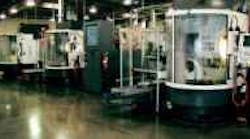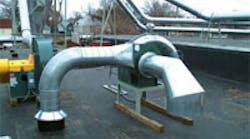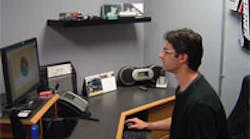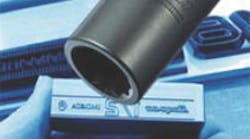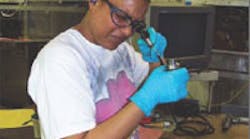Transor filter systems keep fluids cleaner and machines running more efficiently at Promax Tool Co.
Besides machining Inconel 625 exhaust manifold castings, Audi Performance Racing uses its Fadal VMC 4525 to plot coordinates for reverse engineering.
An Anca TX7 grinder reduces fluting time by as much as 4 min/tool at Kim Supply.
Southeast Radiation Products relies on Surfcam software when producing the geometries and toolpaths of tissue compensators for cancer patients.
When PROMAX Tool Co., an end-mill manufacturer from Rancho Cordova, Calif., expanded operations to a 25,000 ft2 facility, it saw an opportunity to increase productivity by adding new technology. One area that needed improvement was its centrifuge-filtration system that left oil running black and required the plant to regularly shut down machines for cleaning and maintenance.
PROMAX wanted a new system that would reduce downtime, minimize maintenance costs, and increase longevity on its machines. So it chose an edge-filtration system from Transor Filter. The new filtration not only increased the machine uptime but lead to a $45,000 increase in productivity for the first 12 months. It also helped extend the life of two prized Walter grinders for an estimated savings of $80,000.
Daryl VanDyke, president of PROMAX, researched several different filtration options, including centrifuge and cartridge filters, but eventually chose the Transor system because it did the best job of cleaning the fluids.
"The Transor filtration system keeps the oil as clear as water," says VanDyke. "We have a number of machines that have been running on the same fluid since we moved here 11/2 years ago. It's almost unbelievable until you see it."
The Transor system operates on the principle of edge filtering and provides oil filtered to 1 µ with one pass through the filter elements. In normal operation, the oil is forced from the O.D. of the element toward the I.D. with all material larger than 1 µ being trapped on the filter edge. The filters are then automatically cleaned with compressed air.
On PROMAX's two Walter grinders, the Transor system decreased yearly maintenance costs and doubled diamond wheel life. It also slashed labor and filter replacement costs.
In addition to minimizing maintenance, the Transor system has increased the longevity of the Walter grinders. "When we put the new filtration on two of our fouryearold Walters, we got an extra year out of those systems. We feel that the new filter will extend the life of our new Walter by two years," VanDyke explains.
Reclaiming carbide was another added benefit. With the centrifudge system, PROMAX did not reclaim any carbide, but with Transor, they reclaimed nearly $3,000 per year.
Transor Filter USA
ELK GROVE VILLAGE, ILL.
transorfilterusa.com
A VMC that's a CMM
When Audi Performance Racing (APR) brought machining operations in-house, it purchased a Fadal Performance Series VMC 4525 for machining Inconel 625 exhaust-manifold castings. However, the Auburn, Ala., racing-products company soon discovered another use for the vertical machining center — as a CMM for reverse engineering.
Using the machine's probing cycle, APR plots the coordinates of a stock manifold to create a representation of where its mating flanges are located for the turbo head and cylinder-head sides.
Once this relationship is captured, the values go to the CAD system.
"The VMC 4525 is ideal for digitizing or reverse engineering because it provides accuracy of 0.00016 in.," says Varun Mahajan, APR manufacturing engineer. It also eliminates the need for a dedicated CMM.
In addition to its use in reverse engineering, the probe cycle increases part accuracy and reduces setup time for APR's manifolds. "Using the probing cycle lets us take into account casting defects and clamping forces to quickly get exact hole centers on parts," says Mahajan.
Hole position is critical to manifold performance. If the holes are out of position, the ports won't mate properly with the engine block. This causes turbulence in the air/fuel mixture flow, which, in turn, neutralizes the impact of a custom manifold.
Conventionally, shops use edge finders to determine correct hole positions on manifolds, but if ports are elliptical, the process is inaccurate. The VMC 4525 probes as many sides as necessary to locate the true center of such holes.
As an actual machining center, the VMC 4525 features heavy castings, boxways, and 40-mmdiameter ballscrews, all of which provide the needed rigidity for machining the ports and holes on APR's manifolds. Highperformance AC axis-drive motors deliver 900-ipm rapids and 600-ipm cutting feedrates at 150%. With 3,800 lb of thrust, the machine easily handles tough materials like Inconel 625 and stainless steel 316. "The VMC 4525 is fast," says Mahajan. "Typical speed for cutting Inconel with a 3-in. cutter is 150 mm/min at 250 to 300 rpm."
Fadal
CHATSWORTH, CALIF.
fadal.com
Grinder meets medical demands
About four years ago, Kim Supply Co. of Montpelier, Ohio, decided to get serious about the tool-grinding part of its business. As a result, the company now specializes in fluting and regrinding tools, with medical being one of its main markets.
Kim flutes stainless steel cutting tools used in reconstruction and surgery. Tolerances for such tools are tight, and geometries are more sophisticated than with conventional tools. To grind these demanding parts, the shop uses an Anca TX7 grinder.
On several jobs, the machine saves Kim up to 4 min of fluting time. "One tool we run 200 at a time," says Jeff Thomas, president of Kim Supply. "The Anca reduces cycle time from 6 min/tool to 2.5 min, saving us more than 11.5 hr of grinding time."
Because Kim produces a wide range of tools, rapid changeover is critical, and the TX7 performs a complete changeover of wheel pack, coolant system, workholding collet, and pallet in less than 3 min. "Typical machines require 15 min to several hours to change over for another tool type," says Thomas. Kim prepares wheel packs and corresponding coolant manifolds off-machine and quickly exchanges them for grinding a new job on the TX7.
With the machine's direct-drive, high-speed (3,000-rpm) workhead, the shop can do cylindrical grinding operations in the tool-grinding process without changing the setup. It can also grind stepped or tapered blanks to a final tool.
In addition, the TX7's CNC wheel changer lets Kim apply two wheel packs to one application, thus accomplishing more operations in a single setup. The machine also includes automatic wheel dressing, which is critical in unattended operation. Unlike most other systems, the Anca uses seeded-gel abrasive wheels (developed by Anca and Norton Abrasives UK) that combine extruded abrasive whiskers with a conventional resin bond. The mix produces an open wheel structure that makes for better coolant penetration and chip removal for longer wheel life.
On the software side, Anca's CIMulator3D provides an off-line tooldevelopment environment that lets Kim's programmers efficiently design new tooling without stopping current production. While typically used as an off-line workstation, CIMulator3D also runs on the machine's CNC to simulate tool programs prior to actual grinding.
Anca Inc.
FARMINGTON HILLS, MICH.
anca.com
Software helps fight cancer
Tissue compensators are small, precisely machined blocks of brass or aluminum that sit in between cancer patients and the radiation machines used to treat them. Varying the thickness of these compensators gives doctors exact control over the amount of radiation that—gets through. Southeast Radiation Products (SRP) in Central Florida machines such compensators and has recently broken new ground by developing a way to more efficiently produce them.
Working with its local Surfcam distributor, CAMed Technologies, SRP developed an application-programming-interface (API) extension that transfers a matrix of polar coordinates generated by a hospital or treatment center into the Surfcam environment. The API generates the 3D surfaces, machining boundaries, and patient-tracking information — everything needed to machine compensators.
SRP calls its system .decimal (Digitally Enhanced Compensation Intensity Modulation with Aluminum). The process starts with X, Y, and Z coordinates sent by the hospital or treatment center via the Internet to SRP. The company then runs this data, using the Surfcam API, into the .decimal system, which automatically generates the compensator's surface geometry as well as necessary toolpaths. After receiving the patient information, SRP can produce a compensator in 9 hr.
SRP prepares compensator blanks in advance on Mazak lathes, so the parts can bolt onto tombstones from behind with no clamps in the way. It then takes a progression of tools — a 21/2-in. face mill, 1/2-in. ball mill, a 5/16-in. ball mill, and an engraving tool — to finish mill the compensators. Once completed, a Renishaw touch probe inspects the parts.
"Not only is geometry and toolpath generation automatic, so is actual machining," says Richard Sweat, president of SRP. The shop mounts eight blanks — two per side onto a tombstone in a Haas 4-axis machining center. "This makes it literally a pushbutton operation," says Sweat. "We start the machine, and it cuts for four or five hours straight."
Surfware Inc.
WESTLAKE VILLAGE, CALIF.
surfware.com
Plasma cutter cleans up dirty power
Drops and fluctuations in voltage, known as dirty power, were hampering the use of critical equipment like plasma cutters at Peterson Manufacturing Corp. in Embarrass, Wis. As result, an old 40-amp cutter had difficulty cutting the various sizes of mild steel used to create the company's farm products.
The cutter's arc would extinguish or not penetrate at all when running off the shop's outlets, and slag buildup on the backside of the cut needed to be knocked off with a hammer. Besides this aggravation, parts required an additional grinding and polishing step. "A cutter of that size and rated output should have no problem cutting through materials up to 1/2-in. thick, but it did because of the power fluctuations," says Peterson's Chris Suess.
As luck would have it, Peterson became a test site for the Spectrum 625 plasma cutter from Miller Electric. At the end of the test period, Peterson was so impressed with the unit's performance that it purchased one.
The 625 features line-voltage-compensation (LVC) technology that ensures a steady arc, and it manages input power anywhere from 176 to 264 V. It's a 40-amp system with a rated cut of 1/2 in., but it also makes quality cuts in mild steel up to 5/8-in. thick. "The new machine takes care of voltage fluctuations," beams Suess. "And it cuts a lot smoother."
Peterson uses the 625 for several jobs. For instance, it cuts 1/4-in. steel caps off piping that supports 6-channel steel used on the company's feeder products. A string of caps that took 10 min now takes 5 min because of the 625's steady arc and the elimination of the added cleanup steps. In addition, the system's pilot-arc controller extends tip life by boosting pilot current only when needed for a strong arc transfer. Suess estimates that for every 10 tips changed on the older machine, he's only had to change three on the new one.
Miller Electric Mfg. Co.
APPLETON, WIS.
millerwelds.com
[email protected]
